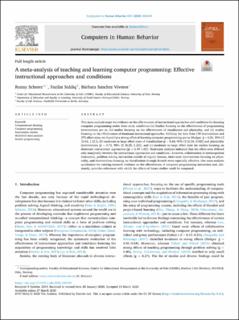A meta-analysis of teaching and learning computer programming: Effective instructional approaches and conditions
Peer reviewed, Journal article
Published version
Permanent lenke
https://hdl.handle.net/11250/2649258Utgivelsesdato
2020Metadata
Vis full innførselSamlinger
Originalversjon
Scherer, R., Siddiq, F., & Viveros, B. S. (2020). A meta-analysis of teaching and learning computer programming: Effective instructional approaches and conditions. Computers in Human Behavior, 106349. doi:https://doi.org/10.1016/j.chb.2020.106349 10.1016/j.chb.2020.106349Sammendrag
This meta-analysis maps the evidence on the effectiveness of instructional approaches and conditions for learning computer programming under three study conditions: (a) Studies focusing on the effectiveness of programming interventions per se, (b) studies focusing on the effectiveness of visualization and physicality, and (c) studies focusing on the effectiveness of dominant instructional approaches. Utilizing the data from 139 interventions and 375 effect sizes, we found (a) a strong effect of learning computer programming per se (Hedges’g = 0.81, 95% CI [0.42, 1.21]), (b) moderate to large effect sizes of visualization (g = 0.44, 95% CI [0.29, 0.58]) and physicality interventions (g = 0.72, 95% CI [0.23, 1.21]), and (c) moderate to large effect sizes for studies focusing on dominant instructional approaches (s = 0.49–1.02). Moderator analyses indicated that the effect sizes differed only marginally between the instructional approaches and conditions—however, collaboration in metacognition instruction, problem solving instruction outside of regular lessons, short-term interventions focusing on physicality, and interventions focusing on visualization through Scratch were especially effective. Our meta-analysis synthesizes the existing research evidence on the effectiveness of computer programming instruction and, ultimately, provides references with which the effects of future studies could be compared.

